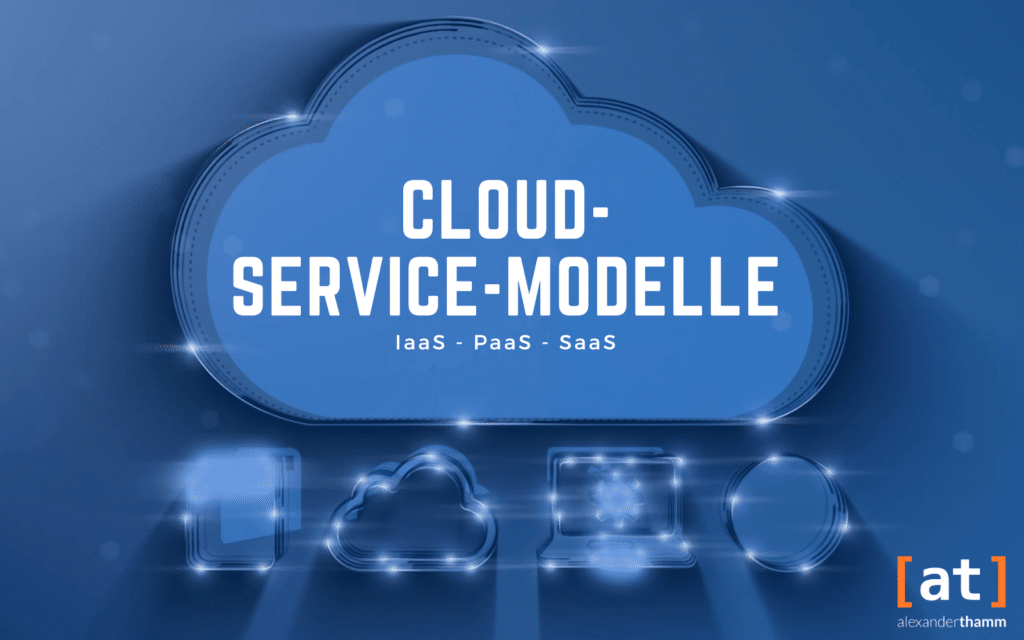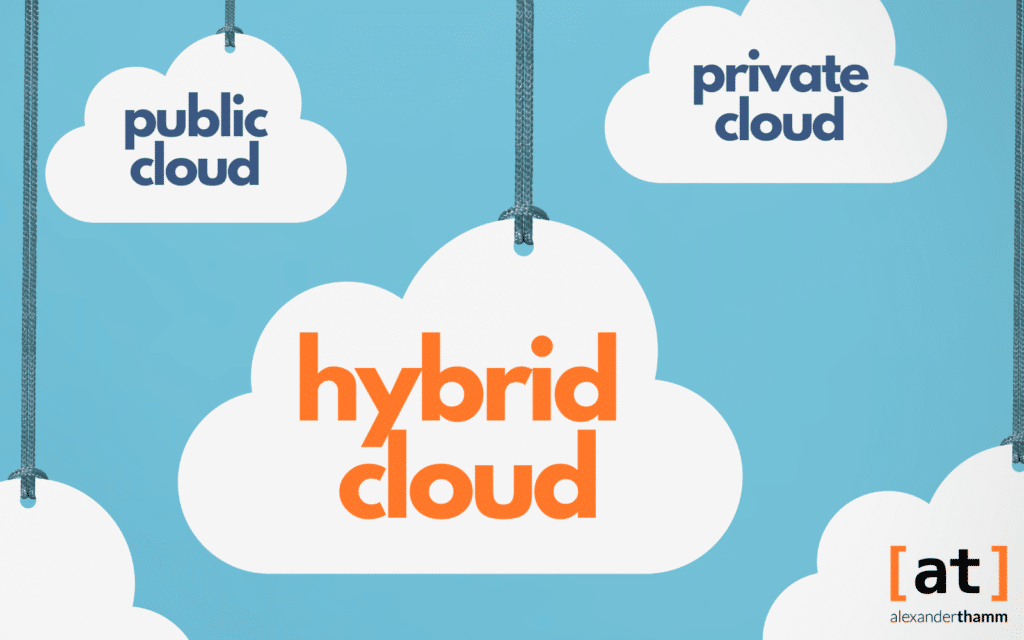Cloud computing has become an indispensable part of many companies in this age of technological progress. The reason is simple: with cloud computing, companies can use their IT resources more flexibly and cost-efficiently. The cloud architecture plays a central role in this. But what exactly is meant by this term and how does a cloud architecture work? In this article we will explain the most important aspects of cloud architectures and infrastructures in a compact way.
Inhaltsverzeichnis
What is a cloud architecture?
A cloud architecture describes the structure of cloud computing systems and defines how various components work together to create a to provide a certain service. A cloud architecture typically consists of various components, including Cloud provider, virtualisation technologies, network infrastructures and management tools. The architecture defines how these components interact with each other to deliver cloud services. At its core, a cloud architecture is about making IT resources and applications flexible and scalable in the Cloud and at the same time ensure the security and availability of the Data and applications.
Components of the Cloud
A cloud architecture consists of various components that work together to create a cloud-based infrastructure. The four main components of a cloud architecture are described below:
- Front-end platformThe front-end platform is the interface between the user and the cloud infrastructure. It provides the user interface through which the user can access the applications and services of the cloud.
- Back-end platform: The back-end platform is the component of the cloud infrastructure responsible for processing the data and running the applications. This is where the resources of the cloud are provided and managed.
- Cloud-based delivery model: The cloud-based delivery model refers to the way in which cloud resources are delivered. There are three common models: Infrastructure as a Service (IaaS), Platform as a Service (PaaS) and Software as a Service (SaaS).
- Network: The network connects the different components of the cloud infrastructure with each other. This can be the public internet, a private intranet or an intercloud. The network architecture is crucial for the performance and security of the cloud infrastructure.
These four components work together to create a cloud architecture that is flexible, scalable and cost-efficient.

In our article on cloud service models, we inform you about the differences between the three different services - Infrastructure-as-a-Service (IaaS), Platform-as-a-Service (PaaS) and Software-as-a-Service (SaaS) - and the benefits for your company.
How the cloud architecture works
A cloud architecture enables companies to use and manage applications, data and services via the internet. The architecture is made up of different components that Together, a highly available, scalable and secure cloud infrastructure provide.
The most important components include Cloud platforms and services such as Amazon Web Services, Microsoft Azure and Google Cloud Platform. Virtual machines and Container provide an efficient way to deliver applications, while load balancers ensure that traffic is optimally distributed between different resources. Databases make it possible to store and manage data in the cloud while Network services how virtual private clouds provide the necessary isolation and security. Automation tools such as Ansible, Chef and Puppet simplify infrastructure management and save time and costs. The Security of the cloud infrastructure is ensured by various security services such as encryption, access control and compliance tools.
In summary, a cloud architecture offers companies more Flexibility, agility and cost efficiency in the provision and management of applications and services in the cloud.
Advantages and benefits for companies
A cloud architecture offers companies numerous advantages and benefits. Here are some of the most important:
- ScalabilityThe cloud architecture allows companies to scale their infrastructure quickly and easily. They can add or reduce resources as needed without having to invest in hardware or infrastructure themselves. Scalability is one of the biggest and most defining advantages when it comes to cloud technology.
- Cost efficiency: Since companies only pay for the resources they actually use, using cloud services can be more cost-efficient than running their own infrastructure.
- FlexibilityCloud services offer companies greater flexibility in their choice of operating systems, programming languages and applications.
- SecurityCloud providers usually invest heavily in security measures and often offer more security than companies can build themselves.
- EfficiencyCloud services can increase business efficiency by saving time and resources that would be spent on maintaining and operating infrastructure.
- Accessibility: Cloud architecture allows companies to access their data and applications from anywhere as long as they have an internet connection.
- InnovationCloud services provide businesses with access to new technology and can foster innovation by enabling companies to quickly try out and implement new ideas.
These benefits make the use of a cloud architecture attractive for many companies and can help to improve business results.

Cloud computing offers numerous advantages and functions for operational processes. Read all the relevant information about this technology in our introductory article:
What is cloud infrastructure?
A cloud infrastructure comprises the Physical and virtual resourcesrequired for the provision of cloud computing services. These include Computing power, storage, network and security components and management tools. These resources can be provided by a cloud provider or a company running a private cloud environment.
In contrast to traditional IT infrastructures, where physical servers, network components and storage devices are installed on site, these resources are virtualised and provided as a service in the cloud infrastructure. The scaling and management of these resources is taken over by a cloud provider, giving companies the ability to react quickly and flexibly to changing requirements.
Cloud infrastructures can be deployed as public, private or hybrid clouds, depending on the needs. A public cloud is operated by a cloud provider and is accessible to the general public, while a private cloud is provided by a company for internal use. A hybrid cloud combines the advantages of both approaches and allows companies to flexibly switch between the two environments.
The cloud infrastructure is the Foundation for all cloud-based services and enables companies to provide IT resources flexibly, quickly and often at low cost.
Advantages and benefits for companies
In addition to the advantages and benefits already mentioned, such as scalability and cost savings, the following points continue to play a role for modern companies that should not be underestimated.
- Improved cooperationCloud infrastructures facilitate collaboration between teams and employees by enabling access to data and applications from any location and at any time. This allows teams to work remotely and still collaborate effectively.
- Higher securityCloud infrastructures usually offer higher security standards than local IT infrastructures. Most providers use modern encryption technologies and firewalls to protect their customers' data. In addition, cloud infrastructures offer a high level of redundancy to ensure that data is not lost in the event of a failure.
- Easy maintenance and updating: The maintenance and updating of a cloud infrastructure is usually done automatically and without interruptions for the user. This way, applications always stay up to date and the IT infrastructure always remains state of the art.

Cloud migration is the transfer of corporate data and content to the cloud. Find out more about the prerequisites, strategies and processes in our article:
What is Cloud Infrastructure Management?
Cloud infrastructure management refers to the Management and monitoring of the infrastructurerequired for the provision of cloud services. Management encompasses a variety of tasks, such as scaling resources, monitoring performance and availability, ensuring infrastructure security and managing user access.
Most cloud providers offer tools and services that can help companies manage their cloud infrastructure. Cloud infrastructure management is an important part of cloud utilisation as it ensures that the cloud infrastructure meets the needs of the business and runs smoothly.
Types of cloud computing architectures and infrastructures
There are four types of cloud architectures or infrastructures that can be used by companies:
Public Cloud
A public cloud is a cloud infrastructure operated by a cloud provider that can be accessed from anywhere via the internet. The infrastructure is shared by many users, making high scalability necessary, but reducing the cost factor. Companies can quickly access the infrastructure without having to worry about provisioning and managing the physical infrastructure.
Private Cloud
A private cloud is a cloud infrastructure operated by a company that can only be used by the company's employees. The infrastructure is physically isolated and offers more control and security than a public cloud. Companies can adapt the infrastructure to their specific requirements and are not dependent on the restrictions of a cloud provider. However, the administrative responsibility here lies with the company itself.

For a full technical overview of the added values and differences between the two cloud delivery models, public and private cloud, see our blog:
Hybrid Cloud
A hybrid cloud combines a public cloud and a private cloud. Companies can take advantage of both infrastructures by running certain applications and data in the public cloud and other applications and data in the private cloud. A hybrid cloud allows companies to combine the advantages of the public cloud (e.g. cost savings and flexibility) with the advantages of the private cloud (e.g. control and security).

Hybrid cloud solutions offer companies even more flexibility and security. Find out from us about the benefits and challenges of integrating this cloud model:
Multi-Cloud
A multi-cloud strategy refers to companies using multiple cloud providers to host their applications and data. This can help reduce dependence on a single provider and increase flexibility by using different cloud services for different needs. Companies can also create geographical redundancies and store their data in different regions or countries.
What products and services exist?
At Cloud computing there are a variety of products and services provided by different providers. Here are some of the best known:
- Amazon Web Services (AWS)AWS offers a wide range of cloud-based products and services, including computing power, storage, databases, analytics and more, artificial intelligence and much more. AWS is one of the largest and most widely used cloud providers.
- Microsoft AzureAzure is a cloud-based platform from Microsoft that offers a wide range of services for deploying, managing and scaling applications and services. Azure also provides integrated tools for cloud application development.
- Google Cloud Platform (GCP)GCP offers a wide range of cloud services for computing, storage, networking, databases, analytics and artificial intelligence. The platform is designed for developers and enterprises and provides appropriate tools for the development and deployment of apps and applications.
- IBM Cloud: IBM Cloud provides cloud services for computing, storage, networking, analytics, artificial intelligence, blockchain and more. The platform is designed for enterprises and offers integrated tools for developing and managing applications.
- Oracle CloudOracle Cloud also offers a wide range of cloud services for computing, storage, databases, analytics, artificial intelligence and other uses. Similar to IBM Cloud, the platform is designed for enterprises and can be used to manage individual applications or groups of applications - but it also includes development-based elements.
Do you have questions about the integration of cloud services in your company? Then please do not hesitate to contact us. We are happy to be at your disposal at any time and offer non-binding advice.











0 Kommentare